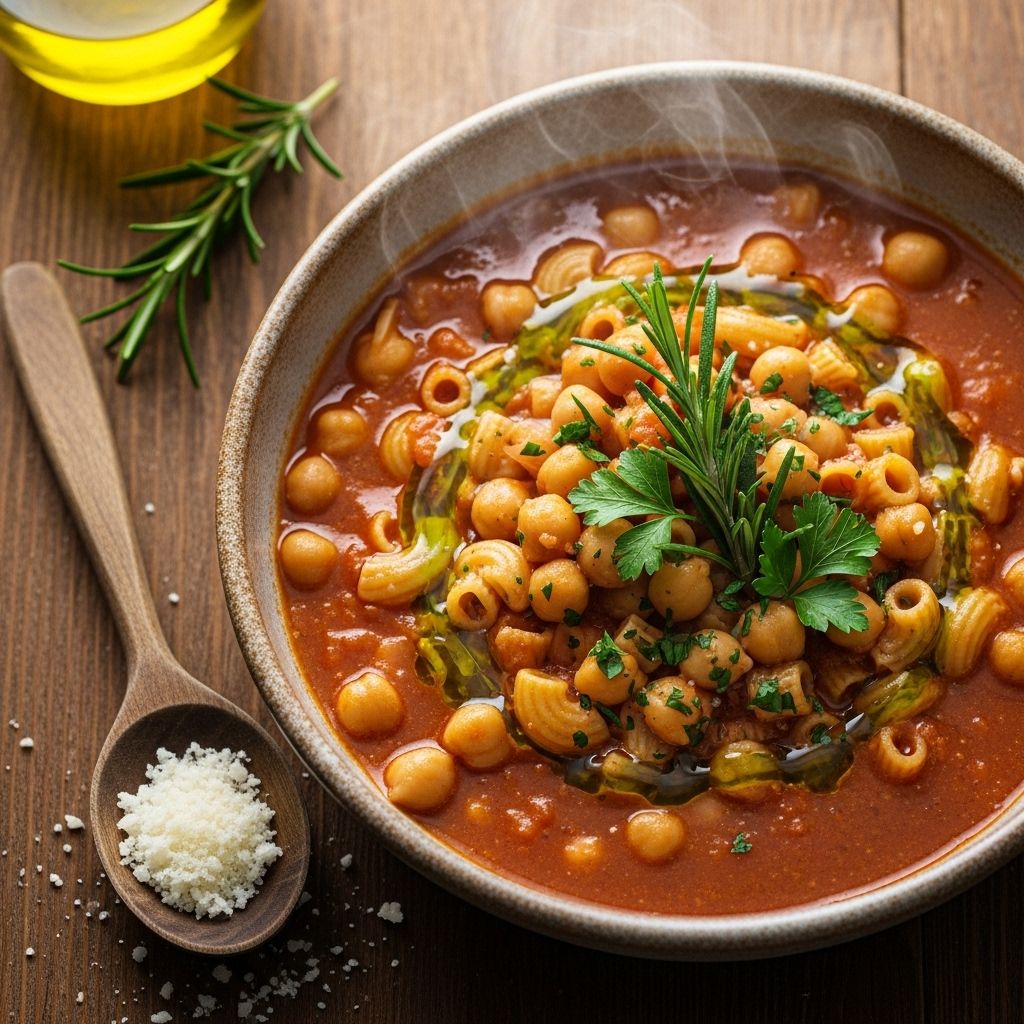Pasta e Ceci: The Italian Classic of Pasta with Chickpeas
Every spoonful blends humble ingredients into a rich, soul-warming bowl of comfort.

Pasta e ceci, or pasta with chickpeas, sits at the heart of Italian comfort food—a humble, soulful stew that celebrates simplicity and robust flavor. With roots tracing back to Roman times and centuries of home cooking across Italy, this dish remains a staple, prized for its economy, nourishment, flexibility, and, above all, deliciousness.
Introduction to Pasta e Ceci
This classic Italian dish consists of small pasta cooked with chickpeas (ceci), tomatoes, aromatics, and olive oil, all simmered together to produce a brothy, satisfying, one-pot meal. Pasta e ceci shines as an example of cucina povera—the Italian tradition of transforming simple, accessible ingredients into deeply comforting food.
- Versatile: Variations span regions, seasons, and available ingredients.
- Hearty and vegetarian-friendly: Packed with plant-based protein and fiber from chickpeas.
- Rich in flavor: Relies on a careful layering of onion, garlic, rosemary, and the deep umami of tomatoes and olive oil.
Origins and Traditions
Pasta e ceci has ancient origins, likely stemming from Roman peasant food traditions where chickpeas and grains were mainstays. Its reputation as cibo povero (“poor food”) speaks to its role as a sustaining meal for farmers and laborers. Each Italian region—and often each household—puts its own twist on the recipe.
Regional Variations
- Central Italy (Lazio, Abruzzo): Often soupier, with garlic, rosemary, and sometimes anchovy.
- Southern Italy (Campania, Puglia): More robust tomato flavor, sometimes with spicy chili flakes.
- Sicily: May include pasta mischiata (mixed shapes) and a hint of saffron.
Essential Ingredients
Although countless versions exist, most pasta e ceci recipes share a common base of:
- Chickpeas: Dried or canned; dried yield better texture and flavor when possible.
- Pasta: Small shapes such as ditalini, tubetti, or broken spaghetti.
- Tomatoes: Canned whole, diced, crushed, or tomato paste for depth.
- Olive oil: For flavor and finishing.
- Aromatics: Onion, garlic, carrot, celery.
- Herbs: Rosemary is classic, sometimes with bay leaf or parsley.
- Broth or water: Chickpea cooking liquid, vegetable broth, or water.
Common Additions
- White wine for deglazing
- Cured meats (pancetta, anchovy) for extra savor (optional)
- Red pepper flakes for heat
- Grated Parmesan or Pecorino cheese for serving
- Fresh greens such as spinach or escarole added at the end
Techniques: The Art of Layering Flavor
Mere assembly of ingredients is not enough to coax out this dish’s signature depth. Pasta e ceci rests on a series of classic Italian techniques:
Building the Flavor Base (Soffritto)
Start with a modest soffritto—slowly sweat onion, celery, and carrot in olive oil until sweet and soft. These aromatics are the foundation of savory flavor, infusing every bite.
Balancing Soup and Stew
- The dish should straddle the line between soup and pasta: brothy enough to spoon up, but thickened with the starches of chickpeas and pasta.
- Some cooks blend a portion of the chickpeas into the broth for extra creaminess, while others keep the legumes whole for texture contrast.
Finishing Oil & Cheese
A final drizzle of extra-virgin olive oil and a grating of Pecorino Romano or Parmesan elevate the dish, adding aroma and savor.
Step-by-Step: Classic Pasta e Ceci Recipe
Below is a detailed guide for a traditional version using dried chickpeas. Substitute canned for a quicker weeknight meal.
Ingredients
- 1 pound (450g) dried chickpeas (or two 15-oz cans cooked chickpeas)
- 8 cups vegetable broth (or chickpea cooking liquid, or water)
- 3 tablespoons extra-virgin olive oil, plus more for serving
- 1 medium onion, finely chopped
- 1 carrot, finely diced
- 1 rib celery, finely diced
- 3–4 garlic cloves, minced
- 1 sprig fresh rosemary
- 1/2 cup dry white wine (optional)
- 1 cup whole peeled tomatoes, hand-crushed (or 2–3 tbsp tomato paste)
- 1/2 pound (225g) ditalini, tubetti, or other small pasta
- Kosher salt and black pepper to taste
- Grated Parmesan or Pecorino Romano for serving
- Red pepper flakes (optional)
Instructions
- If using dried chickpeas: Soak overnight in plenty of water. Drain, then simmer in fresh salted water or broth until just tender, 1–1.5 hours. Reserve at least 4 cups cooking liquid.
- Prepare the base: In a large saucepan or Dutch oven, heat olive oil over medium heat. Add onion, carrot, and celery and cook gently until softened, about 8–10 minutes. Add garlic and rosemary; cook until fragrant, about 1 minute.
- Deglaze: Pour in white wine, if using, and cook until almost completely evaporated.
- Add tomatoes: Stir in hand-crushed tomato, cooking until some liquid evaporates and the flavors meld, about 5–7 minutes. (Alternatively, use tomato paste for a deeper, concentrated flavor.)
- Simmer chickpeas: Add chickpeas and enough broth or cooking liquid to cover everything by an inch. Bring to a gentle simmer and cook 20 minutes to meld flavors.
- Thicken: For a creamier base, blend or mash about one-third of the chickpeas in the pot. This step is optional but adds body.
- Cook pasta: Stir in ditalini or other small pasta directly into the broth. Simmer, stirring occasionally, until pasta is just al dente, about 8–10 minutes. Add more liquid as needed to keep things soupy but thick.
- Season: Remove rosemary sprig. Add salt, black pepper, and red pepper flakes (if desired) to taste.
- Serve: Ladle into bowls. Finish with a swirl of extra-virgin olive oil and a rain of grated Parmesan or Pecorino. Serve immediately, with more cheese on the side.
Nutritional Highlights
- Excellent source of protein and fiber from chickpeas.
- Low in fat (if cheese is omitted or minimized).
- Packed with vitamins and minerals from vegetables and legumes.
- Can be made vegan by omitting cheese or using a plant-based alternative.
Popular Variations
Because of its rustic character, Pasta e ceci easily adapts to both necessity and creativity. Consider these takes:
- Brothier (soupy) version: Add more liquid to yield a spoonable soup; classic in Rome and central Italy.
- Tomato-rich version: Let tomatoes dominate for a redder, saucier stew (common in Southern regions).
- Greens added: Wilt in chopped spinach, escarole, or even kale in the final minutes for a boost of color and nutrition.
- Spicy version: Sprinkle with chili flakes or a touch of fresh chili for gentle heat.
- Different pasta shapes: Use broken spaghetti, orzo, or whatever small pasta you have on hand.
- Gluten-free: Opt for gluten-free pasta to accommodate dietary needs.
| Variation | Key Differences |
|---|---|
| Central Italian (Roman) | Soupier, garlic and rosemary, sometimes anchovy |
| Southern Italian | Heavier tomato, spicy, thicker consistency |
| Sicilian | Mixed pasta shapes, saffron |
| Vegetable-enhanced | Spinach, escarole, or zucchini added |
| Canned chickpeas | Ultra-quick version, skip soaking and long simmer |
Cook’s Tips for the Best Pasta e Ceci
- Use dried chickpeas when possible: The flavor and texture are superior, but canned will do in a pinch for speed.
- Don’t overcook pasta: Cook until just al dente, as it will continue softening in the hot broth. Serve promptly.
- Layer flavors: Let the soffritto cook low and slow; don’t skimp on the olive oil.
- Balance consistency: Adjust with more liquid if needed. The texture should be hearty but not dry or gluey.
- Finish with good olive oil: A drizzle at the end brightens the entire bowl.
- Season well: Chickpeas and pasta absorb salt—taste and correct seasoning before serving.
Serving Suggestions & Leftovers
- Best served fresh: The mixture thickens as it cools; add a splash of hot broth or water to loosen leftovers.
- With bread: Crusty Italian bread makes the perfect partner for scooping up the last bites.
- As an entrée or first course: Hearty enough for a meal, or as part of a larger Italian dinner.
- Refrigerate leftovers: Store up to three days; reheat gently with additional liquid.
Frequently Asked Questions (FAQs)
Q: Can I make pasta e ceci vegan?
A: Absolutely! The base recipe is naturally vegan if you omit the cheese or use a vegan cheese alternative.
Q: What size pasta is best?
A: Small shapes like ditalini or tubetti are traditional, but any small pasta or even broken spaghetti works well.
Q: Can I use canned chickpeas?
A: Yes. Rinse and drain before using. They cut down cooking time and are perfect for a quick weeknight meal.
Q: Can I make it ahead of time?
A: You can make the stew ahead, but add the pasta only when ready to serve to avoid mushiness from overcooking in reheated broth.
Q: Is pasta e ceci gluten-free?
A: The base is gluten-free; simply use a gluten-free pasta to adapt the dish.
Pro Tips for Perfect Pasta e Ceci Every Time
- Infuse with rosemary: Tie sprigs with kitchen twine for easy removal if you want a subtler flavor.
- Try a finishing oil: Warm olive oil with garlic, rosemary, and chili flakes to drizzle over plates as in Roman trattorias.
- Add greens or vegetables: Wilt in greens or toss in diced zucchini, fennel, or carrots for color and nutrition.
- For a richer flavor: Add a dollop of tomato paste or sautéed anchovy in the soffritto.
Conclusion
Hearty, deeply nourishing, and endlessly versatile, pasta e ceci earns its reputation as one of the most satisfying dishes in Italian home cooking. Whether you follow a tried-and-true family formula or riff with what’s on hand, this beloved pasta and chickpea stew offers comfort, tradition, and lingering pleasure in every spoonful. Buon appetito!
References
Read full bio of Srija Burman












